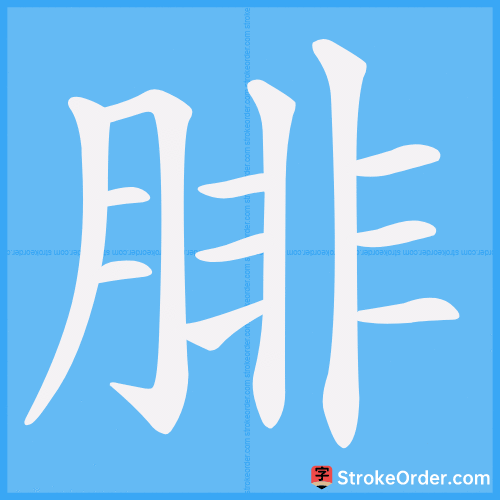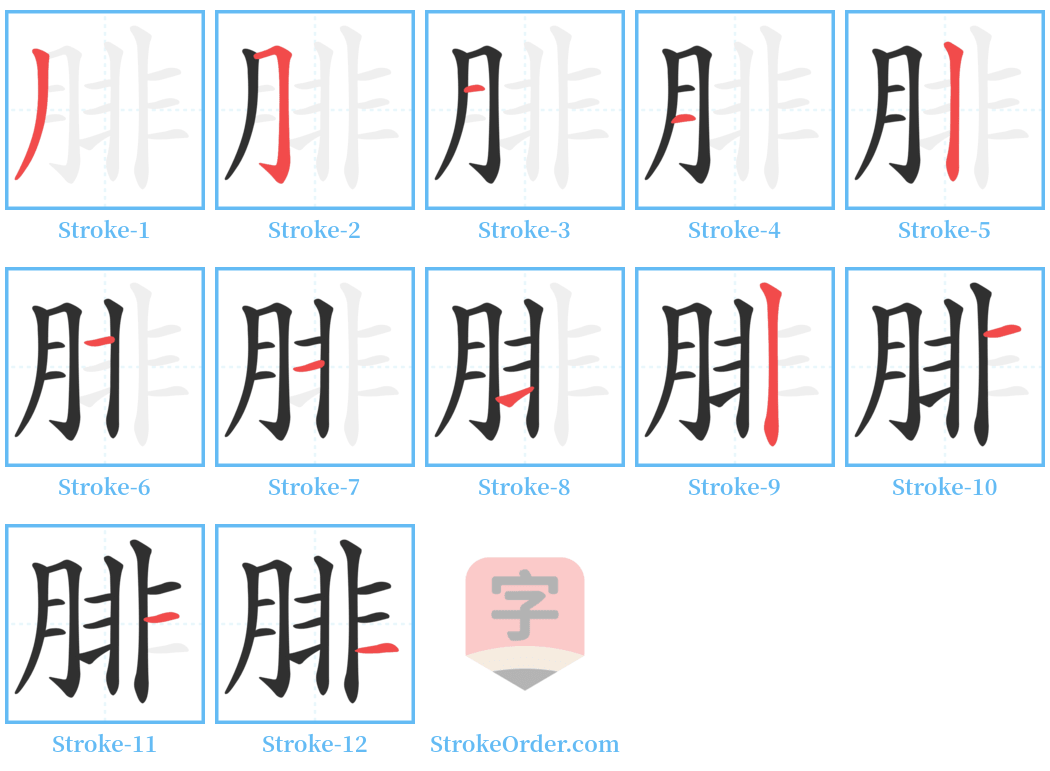腓 Stroke Order
Animated Stroke Order of 腓

Stroke Order Diagrams for 腓

Step-by-Step Handwriting Guide for 腓

Learn to Write Chinese Characters with Video Tutorials
Watch the video of writing the Chinese character "腓", learn the correct stroke order (笔顺) of the character "腓", and master the standard way of writing the character "腓".
Free Printable Handwriting Practice with Stroke Order: 腓
Printable Writing Practice Worksheet of "腓" in Portrait Orientation (Tian Zi Ge)

Printable Writing Practice Worksheet of "腓" in Landscape Orientation (Tian Zi Ge)

Information of 腓
Pinyin
féi
Radical
月
Strokes
12 strokes
Usage
★★★★
Definition
calf of leg / decay / protect
腓 [féi]
1. 胫骨后的肉。亦称“腓肠肌”,俗称“腿肚子”。
(Calf (of the leg), specifically the flesh behind the tibia; also known as the gastrocnemius muscle, commonly referred to as "leg belly".)
2. 覆庇,倚庇。
(To cover or shelter.)
3. 草木枯萎。
(To wither; refers to plants and vegetation.)
4. 疾病。
(Illness.)
5. 弊端。
(Abuse, deficiency.)
6. 古代剔除膝盖骨或断足的酷刑。
(A cruel torture, specifically the ancient method of removing the kneecap or amputating a foot.)
引文 Examples:
- 《韩非子》: 腓大于股,难以趣走。 (From Han Fei Zi: The calf is larger than the thigh, making it difficult to run quickly.)
- 南朝 宋·鲍照《代苦热行》: 毒泾尚多死,渡泸宁具腓。 (In the Southern Dynasty, Song, Baozhao’s “Poem on Suffering from Heat”: There are many deaths from poison; crossing the Lu River while still suffering from illness.)
- 元·许有壬《哀弃儿》: 十年执政虽咸腓,发廪有议常坚持。 (In the Yuan Dynasty, Xu Youren’s “The Abandoned Child”: Although there were abuses during ten years of governance, the decisions regarding food storage were often upheld.)
- 汉·班固《白虎通·五刑》: 腓者,脱其膑也。 (In the Han Dynasty, Ban Gu's "White Tiger Commentary": "腓" refers to the removal of the kneecap.)
形 (Adjective):
病害; 枯萎。多指草木。
(Referring to illness or withering, mainly of plants.)
引文 Examples:
- 《诗·小雅·四月》: 秋日凄凄,百卉具腓。 (From the Book of Songs, "Minor Elegance, April": On a sorrowful autumn day, all flowers are withering.)
- 唐·高适《燕歌行》: 大漠穷秋塞草腓,孤城落日斗兵稀。 (In the Tang Dynasty, Gao Shi’s "Song of the Swallows": In the vast desert at the end of autumn, the grass is withering, and the lone city sees the setting sun with few soldiers.)
Input Method for 腓
Pinyin
fei2
Wubi
edjd|ehdd
Cangjie
blmy
Zhengma
qkc
Four Corner
71211
Unicode
U+8153
Same Pronunciation Characters